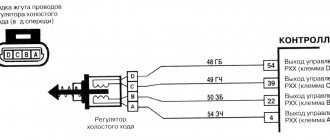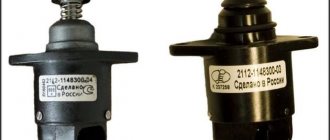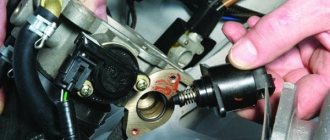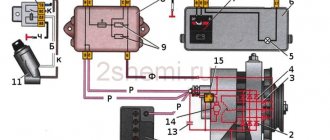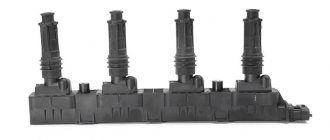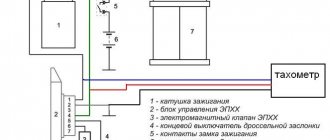Signs of sensor malfunction
Before you repair the device, you need to find out where the idle speed sensor is located. It all depends on the specifics of the vehicle, but as a rule, this controller is located on the throttle assembly, under the throttle position control. If the location of the DXX is clear, then you can find it without any problems.
Before checking the idle air control, familiarize yourself with the main faults specific to the part:
- the power unit has become less stable at idle;
- engine speed may increase or decrease for no reason;
- when switching to neutral speed, the engine may simply stall;
- if the power unit starts cold, there will be no increased speed;
- when an additional load in the form of a stove, air conditioner or optics is turned on, the engine speed drops significantly.
Idle speed sensor device
Cleaning the regulator on a VAZ 2114
Cleaning IAC on VAZ 2114
In order to get the sensor, you need to turn off the engine and it is advisable to disconnect the power from the battery. The regulator itself is located on the throttle assembly, just below the damper position sensor, on the injector throttle body.
As a rule, this action can be completely carried out by the car owner himself, since this does not require special skills or tools.
What do you need to prepare?
- Clean cotton rags.
- A small screwdriver.
- Aerosol liquid.
- Any carburetor cleaner.
How to clean the IAC on a VAZ 2114 if it is dirty? Cleaning the product begins with its dismantling, by unscrewing the two mounting screws with a Phillips screwdriver. There are also bolts for torx screwdrivers, so before you start cleaning, you need to make sure you have the right tool at hand.
These design changes depend on the year and type of multiport fuel injection system installed. After removing the mounting bolts, you need to remove the idle sensor from its socket in the throttle (accelerator) block.
This action must be performed carefully, since if the unit is dirty, its seating part may stick slightly to the body.
Next, clean the idle air control using a rag and a special aerosol liquid. It is important to consider that in addition to the sensor, you need to clean the mounting socket itself.
Posts 1 page 8 of 8
Share112.01.2014 21:20
- Author: Mega-ZZZ
- Mega neon guide
- From: coast of the Black Sea Tuapse
- Gender: Male
- Age: 32 [1987-05-11]
- Posts: 2179
- Respect: +564
- Car: Neon, Stratus
- Year of manufacture: 2000, 2003
- Gearbox type: TH-31 TE-41
- Last visit: 11/24/2018 23:40
- Registered: 11/21/2010
- Spent on the forum: 1 month 8 days
Hello again everyone! Once again we touched on the topic of the ’96 Dodge Neon car. Today we will talk about the idle air regulator for the first neon, the actual essence of the device’s operation is very primitive - by extending and retracting the pin, the air supply to the intake manifold is regulated.
Basically, the regulator cannot be repaired and should not be disassembled.
I’ll say right away - banal spraying in the area of the pin itself does not help lubricant get inside the sensor and does not plan to..
The reason I decided to get to the bottom of the sensor is that nonnon behaves very strangely. I'll post a video later.
actually let's go. looks great from the outside :)
We take a drill and drill holes next to the rivets so as not to damage them, we will still need them!!
we get a kind of reusable corner latch-groove :)
a couple of hammer blows and that's the happiness that's inside.
no matter how scary it is, we bite off the wires
Now you can disassemble the valve
here are his insides
here are the windings of 2 of them, the resistance of both of them was 52 ohms!
here is the rotor itself - here it is a magnet with permanent poles, inside of which there is a thread along which the rod rides.
This interesting little thing fell out of him - maybe it was she who was wedging him.
and I also noticed that it clearly jams when it rotates, I lubricated it with silicone and assembled it in the reverse order
The main thing is not to forget to solder the wiring and everything is great - you can go into battle.
I drilled a hole into the groove and screwed in a screw from some Chinese crap - it holds perfectly and is now not difficult to disassemble.
Then all that remains is to check the windings and everything is great, tomorrow I’ll install it and check it :) by the way, now I’m shooting a video, once I edit it I’ll post it, look how I am as a commentator :)))
Edited by Mega-ZZZ (01/12/2014 21:23)
Share212.01.2014 22:01
- Author: dimmaster
- Veteran neon guide
- From: Moscow
- Gender: Male
- Posts: 954
- Respect: +16
- ICQ: 451717023
- Car: Neon
- Year of manufacture: 2002
- Transmission type: automatic transmission
- Last visit: 10/05/2016 20:15
- Registered: 02/24/2012
- Time spent on the forum: 27 days 10 hours
What was the problem?
Share312.01.2014 22:26
- Author: Mega-ZZZ
- Mega neon guide
- From: coast of the Black Sea Tuapse
- Gender: Male
- Age: 32 [1987-05-11]
- Posts: 2179
- Respect: +564
- Car: Neon, Stratus
- Year of manufacture: 2000, 2003
- Gearbox type: TH-31 TE-41
- Last visit: 11/24/2018 23:40
- Registered: 11/21/2010
- Spent on the forum: 1 month 8 days
it feels like it’s jamming, the revolutions should gradually gradually decrease when warming up, but ours is 1200, then something tries, buzzes, and oops - 600 at once, then it almost stalled, they picked up the gas, it picked up again, then again everything worked as it should - then the car sits at idle and warms up, for no reason at all there is a sharp dip again and suddenly it picks up when everything warms up clearly, because the idle speed is no longer particularly regulated when the engine is warmed up.
I decided that there was something wrong with the IAC,
PS the problem with idle appeared gradually, first in the form of unnoticeable stupidities, then obvious failures in operation..
Cleaning Rules
It often happens that cleaning the idle speed sensor can solve the problem of device inoperability. In general, this procedure is quite simple. Therefore, almost anyone can cope with it.
So, how to clean the idle air regulator:
- First of all, the IAC must be disconnected from the wiring.
- Next, take the WD-40 liquid and apply it to a Q-tip. This stick is used to clean contacts.
- Next, take a small Phillips head screwdriver and unscrew the controller latches, there are two of them. If the fastenings are completely missing, this indicates that the IAC is mounted on varnish; if this is the case, then, most likely, the entire throttle will need to be dismantled.
- Dismantle the DXX and inspect it. If there is dirt or traces of motor fluid on the device, then in addition to the regulator itself, you will need to clean the entire throttle assembly.
- Now take a cleaning fluid (you can use carburetor cleaner instead of WD-40) and apply it to the cone needle and spring. Although carburetor cleaner is better for cleaning! Having done this, you need to dry the controller and put it in place. Before installation, make sure that the distance from the device body to the needle is 2.3 cm. If cleaning does not help fix the problem, then most likely you will have to change the DHC.
Controller connection diagram
Let's sum it up
As you can see, the idle speed sensor is an important and critical part in the ECM of a car engine. It is important to understand that the IAC is an electromechanical solution, that is, problems can arise in the electrical or mechanical parts.
We also recommend reading the article about what ELM327 is, what features the ELM327 scanner has, how this solution works and what functionality is available. From this article you will learn about the advantages of the ELM327 scanner, as well as what to look for when choosing this device before purchasing.
In this case, it is important that the sensor works correctly, that power is supplied to it, and that the ECU commands are carried out by the regulator accurately and in a timely manner. For this reason, it is necessary to check the electrical circuits, contacts and connectors, as well as the quality of operation of the regulator needle itself and other sensor elements.
Reasons for failure of the idle speed sensor
The incorrect operation of the IAC can be judged by the following criteria:
- No or unstable idle speed.
- Turning off the engine while the vehicle is moving at neutral speed.
- When warming up in cold weather, the engine speed does not rise to 1500.
- Also, when you turn on electrical appliances, a drop in speed is possible, but this may also indicate a malfunction in the vehicle’s electrical network.
The most common reason for the failure of the idle speed sensor is oil from the boat exhaust system, in other words, from the breather. When this liquid gets on the sensor needle, coking occurs due to the fact that the throttle mechanism is constantly heated by the water system.
This happens quite quickly and noticeable idle problems appear more and more often, directly depending on the condition of the piston system. In some cases, if the engine is heavily worn, it is recommended to disconnect the breather from the air system and seal the inlet before repairing it. This will not only help avoid frequent cleaning of the idle air regulator, but will also help save fuel consumption, because in addition to oil particles entering the air channel, carbon dioxide escapes from the crankcase, which prevents complete combustion of the fuel.
Another common cause of rough idle is a poorly sealed air system. Most often, the auxiliary pipes on the adsorber and the fuel pressure regulator are damaged; the corrugation in the area of the mass flow sensor (mass fuel flow sensor), which is installed on the air filter cover, may burst.
These faults can only be corrected by replacement. As a rule, when the air channels are damaged, an uneven idle is observed with a characteristic hissing under the hood or when the speed is constantly raised.
If the car has covered a lot of kilometers, more than 50,000, then it is advisable to wash the entire throttle assembly, and based on the results, proceed directly to replacing the idle speed unit itself.
Cleaning the idle air regulator - how to do it?
First, the block of wires is disconnected from the sensor itself, and using a cotton swab dipped in a special product, we clean the contacts. Then, using a Phillips screwdriver, remove the sensor to assess its condition. But to do this, we must know where the idle air control is located. You can find it on the throttle body. Sometimes the sensor is mounted on varnish, then it is impossible to do without removing the entire throttle assembly.
If the entire sensor is covered with oil, the throttle valve should also be cleaned, and the conical needle with the spring should also be cleaned using WD-40. If after cleaning there are no changes in the operation of the engine, it means that the wires may have broken, or the cone needle guides have become unusable. In the first case, the wires can be soldered, the soldering area can be degreased with alcohol and varnished (this way you can prevent corrosion of the contact). In the second case, replacing the idle air regulator is inevitable.
Purpose, device and principle of operation
The main components of the idle air control sensor include a cone needle, a stepper motor, a spring and a rod. You can see the insides of the pxx in the image below.
The conical needle is used to change the throughput of the regulator. which affects the amount of air supplied to the engine. The spring is used to create counteraction and eliminate backlash in the operation of the sensor. The stepper motor acts as a drive. Control signals are generated in the ECU, taking into account information from other sensors, for example, the position of the crankshaft or coolant temperature.
The principle of operation of the device is based on changing the cross-section of the air flow channel going into the combustion chamber when the throttle is locked. The stepper motor extends the rod until the tapered needle touches the hole. When you start the machine, the PHH opens the passage, supplying the required amount of air. For a better understanding of the principle of operation of the idle air regulator, you should pay attention to the cross-section of the idle air control shown below.
The operation of the regulator allows for accelerated warming up of the car. When the coolant sensor signals that the engine is operating below the permissible temperature range, the amount of air supplied automatically increases. As a result, the crankshaft speed increases and heating occurs more intensely. Thanks to the pxx injector, you can drive the car immediately after starting the engine, which is not available to owners of carburetor engines.
The pxx is located near the throttle sensor. The stepper motor cover stands out strongly against the background of the assembly. The difficulty of finding where the regulator is located only arises if it is located under a common plastic casing that protects the devices from mechanical damage.
Cleaning Features
How to clean the idle speed sensor on a VAZ 2114 when it is removed and is in the hands of the car owner? It is necessary to spray the tip of the sensor, the so-called needle, with a few clicks on the can.
The needle can be either plastic or metal, but the needle material does not affect the operation of the engine in any way.
Attention: under no circumstances should the liquid itself get into the inside of the sensor (under the spring). If this happens, you need to blow it out with plenty of air. Otherwise, cleaning fluid may enter the sensor mechanism and damage the internal lubrication, which will lead to rapid failure of the idle speed control.
IAC VAZ 2114 disassembled
When cleaning the internal seat of the pxx sensor, it is necessary to correctly dose the cleaning liquid so that after all the procedures you do not have to clean and dry the spark plugs.
Main aspects of checking IAC
We figured out how to clean the idle speed sensor, now we’ll take the time to diagnose it. Like cleaning, testing can be done at home.
How to check the idle speed sensor:
- Find the IAC and remove it along with the wires. Unscrew several clamps that secure the throttle assembly with the receiver, then move these elements apart by about 1 cm.
- Using a diagnostic tester, check the IAC circuit - now you should make sure whether there is voltage in the network or not. Connect the tester probes to contacts A and D - as a rule, they are marked on the body. Having connected the probes, you need to activate the ignition and look at the results. The best option is 12 volts. If this parameter is lower, then most likely the problem lies in a poor battery charge, and if it is completely absent, then it is quite possible that the problem lies in the control unit.
- Make sure that the circuit is on the IAC itself. To do this, the tester's probes must be connected to pins A and B, and then to C and D, and you need to set the tester to ohmmeter mode. When checked, the diagnostic parameters should be about 53 ohms. Then the same actions should be repeated with other pairs of contacts, for example A and C, and the resistance should tend to infinity (the author of the video is Ivan Vasilyevich).
There is another option; for this, checking the idle speed sensor must be carried out with the IAC removed. Connect the power cable, then touch the end of the needle with your finger (no force required). During shutdown, the regulator should begin to extend the needle fully, so when you turn, there should be a slight push of the finger.
As you can see, in general, diagnosing a device is not that difficult, but for a quality test you need to understand how to use the tester. If you have no idea how to do this, it is better to seek help from an electrician, but in practice, after studying the instructions for the multimeter, there should be no problems with its use. Of course, the tester itself must be working, otherwise the readings will not correspond to reality and you will only get confused.
Sorry, there are no surveys available at this time.
Using a Multimeter to Check Valve Resistance Specification
Step 1: Access to the XX valve . For information about the valve position on your vehicle, refer to your vehicle's service manual.
Step 2: Disconnect the valve . Locate the valve's electrical connection and disconnect the idle air valve.
Step 3: Remove the valve from the car . Use the procedure described in your vehicle's service manual to remove the valve.
Step 4: Check the valve . Inspect the valve and mounting location for carbon deposits, rust, or dirt. Check the valve pin and mounting location for damage. Correct these problems before condemning the valve.
Step 5: Check valve resistance . Use the specifications listed in the vehicle's Service Manual for the idle air valve and follow the directions for testing the valve using a digital multimeter on the electrical contacts of the valve's electrical connector. If the value is within specification, the valve should sound as it did, which means the error is elsewhere. If the readings are not within specifications, replace the device with a new one.
Note
The new idle air valve may or may not come with a new gasket. Remember to replace the gasket every time the sealed part is removed from the engine to avoid vacuum leaks or coolant leaks when coolant leaks through the valve body.
Subtleties of purchasing a new IAC
After purchasing a new regulator, you need to configure it. The injector calibrates itself using the computer, so there will be no difficulties with how to change the sensor. To perform the operation automatically, it is enough to de-energize the injector before installing the IAC.
When purchasing a new regulator, you should pay attention to its quality. The valve and other elements must not have any defects or deformations. The quality of contact soldering must be at a high level. Installation on the seat must occur without distortions, otherwise repairs will soon be required.
The air flow passing through the valve solved the issue of engine operation without load. Now the throttle valve is entrusted with the function of controlling dynamic characteristics, and at idle speed the engine is in full control of the rxx. The ability of the sensor to increase speed allows the car owner not to waste time waiting for the engine to warm up.
Features of dismantling
As for dismantling the controller, there is nothing difficult about it. Of course, some points may vary depending on the design features of your vehicle.
But in general the withdrawal procedure looks like this:
- First, the ignition is completely turned off. Just in case, to prevent a short circuit, you can disconnect the negative terminal from the battery.
- The next step is to disconnect the regulator's power wiring. Typically this connector is a four-pin output and can simply be disconnected. On some cars, the wiring block can be fixed using an additional fastener - there is nothing complicated here, you just need to disconnect the fastener.
- After this, the regulator mounting bolts are unscrewed and the controller itself is removed.
After cleaning the throttle body the speed fluctuates
So, it would seem that the whole procedure is over. The damper was cleaned with a cleaner, the air filter was replaced with a new one, the sensors were reconnected, that is, everything was assembled and tightened. Now you can proceed to starting the engine. If the engine starts after cleaning the throttle valve and then runs normally, then the procedure can be considered successful.
It should be added that this is not always the case. Many people are faced with the fact that after cleaning the throttle valve, high engine speeds remain constant and do not drop. Also, many drivers notice that after cleaning the throttle valve, fuel consumption has increased. A likely cause could be an error in connecting some sensor during reassembly, but this rarely happens.
Most often, after cleaning, the throttle also needs to be additionally calibrated and adjusted, which not everyone knows about or does it incorrectly. In other words, high idle speeds after cleaning the throttle valve are a clear example and at the same time an answer to the common question of whether the throttle valve needs to be trained after cleaning this unit. Let's figure it out.
We recommend: How can you care for the interior of your car?
Let's start with the fact that in some cases a pure throttle valve really needs to be adapted (trained). Typically, throttle valve adaptation is often necessary when the electronic throttle valve has been cleaned before. There are fewer problems with a mechanical damper, but they still exist. In systems with an electronic throttle, the ECU independently sets the throttle position; in mechanical systems, the idle air control is set. To put it simply, after removing the layer of dirt, the position of the cleaned damper changes, but the ECU does not know about this and continues to supply fuel in accordance with the previous parameters before cleaning. To solve the problem, it is necessary to set the idle speed using diagnostic equipment, since it is possible to reset the previous parameters.
You can also try teaching the throttle manually. The simplest way to learn without diagnostic equipment or a scanner for adaptation is to unscrew the negative terminal of the battery from a few seconds to 10 minutes (depending on the make and model of the car). This allows you to reset the settings, that is, the existing adaptation is reset and returned to the factory settings. After connecting the terminal to the battery and restarting the engine, the idle speed should stabilize.
Note that this method works on a limited number of cars. In such a case, you can take advantage of another opportunity to train the throttle assembly without a computer. This method is suitable for a range of vehicles from different manufacturers. Let's consider such an adaptation using the example of a Japanese Nissan car.
- First, the engine must be warmed up to operating temperature, after which the engine should be turned off.
- Next, you will need to wait 5-10 seconds, then turn on the ignition for 3 seconds.
- Now you need to press the gas pedal all the way and immediately release it. This is done 5 times, you need to do it in 5 seconds (one press per second). The interval should be timed using a stopwatch so as not to get lost.
- After the last press, you should wait 7 seconds, after which the gas pedal is again pressed “to the floor” and held in this position until the “check” begins to blink on the dashboard, and then this light comes on constantly.
- After the moment when the check code starts to light up constantly, you need to wait another 3 seconds. Now the gas pedal can be released.
- Next, the engine needs to be started, the idle speed should return to normal.
Let us add that during such adaptation of the throttle valve it is important to accurately maintain the timing at each stage, as well as to fit into all time intervals. In this case, we can talk about successful training. It is also recommended to clarify the features and the possibility of manual adaptation for a specific car model.
Installing the sensor in reverse order
Once the sensor and its seat are completely cleaned, complete assembly can begin. To do this, it is important to lubricate the rubber sealing ring with grease or unused oil and carefully install it in its normal place without damaging the integrity of the seal, without which operation of the vehicle will be impossible.
The work is done, now everyone knows perfectly well how to clean the idle air valve. It is safe to continue driving your vehicle.
